“用户:Grotton JXz Donbrako/Psychology/Chapter 3”的版本间的差异
(填充至脑子*2) |
(补充完毕) |
||
| (未显示同一用户的2个中间版本) | |||
| 第1行: | 第1行: | ||
==页面介绍== | ==页面介绍== | ||
| + | (需补充) | ||
本页面所转载文章出自[https://www.appsychprep.com/powerpoint-slides APPsychPrep网站所分享幻灯片]<ref name=emanfer />,由[[User:Grotton_JXz_Donbrako|GJD]]转载。 | 本页面所转载文章出自[https://www.appsychprep.com/powerpoint-slides APPsychPrep网站所分享幻灯片]<ref name=emanfer />,由[[User:Grotton_JXz_Donbrako|GJD]]转载。 | ||
<br> | <br> | ||
转载时有改动,无任何原内容省略。 | 转载时有改动,无任何原内容省略。 | ||
==正文== | ==正文== | ||
| − | === | + | ===Biological Basis of Behavior=== |
*'''Neuroanatomy''' refers to the study of the parts and function of neurons. | *'''Neuroanatomy''' refers to the study of the parts and function of neurons. | ||
*'''Neurons''' are individual nerve cells that make up your central nervous system. | *'''Neurons''' are individual nerve cells that make up your central nervous system. | ||
| 第10行: | 第11行: | ||
---- | ---- | ||
*神 经 元 玉 照.jpg | *神 经 元 玉 照.jpg | ||
| − | <img src="https://pic1.zhimg.com/80/v2-c4a34f978379e78618a78e3702e07c48_720w.jpg" /> | + | <img src="https://pic1.zhimg.com/80/v2-c4a34f978379e78618a78e3702e07c48_720w.jpg" style="width:432px;" /> |
---- | ---- | ||
*'''Dendrites''': Rootlike parts of the cell that stretch out from the cell body. | *'''Dendrites''': Rootlike parts of the cell that stretch out from the cell body. | ||
| 第22行: | 第23行: | ||
*'''Synapse''': This is the gap between the terminal button and the dendrite. | *'''Synapse''': This is the gap between the terminal button and the dendrite. | ||
**'''Synapse'''.jpg | **'''Synapse'''.jpg | ||
| − | <img src="https://media.cheggcdn.com/media/cc1/cc1af41d-c577-45a4-929d-35dee36ce778/28_06aneuroncommunicat-l-14C3389302B480472A5.jpg" style="width: | + | <img src="https://media.cheggcdn.com/media/cc1/cc1af41d-c577-45a4-929d-35dee36ce778/28_06aneuroncommunicat-l-14C3389302B480472A5.jpg" style="width:432px;" /> |
---- | ---- | ||
| − | |||
*'''Neural firing''' is an '''electrochemical process'''. Electricity travels within the cell '''from the dendrites to the terminal buttons'''. | *'''Neural firing''' is an '''electrochemical process'''. Electricity travels within the cell '''from the dendrites to the terminal buttons'''. | ||
*'''Neurotransmitters''' travel between cells in the synapses of neurons. | *'''Neurotransmitters''' travel between cells in the synapses of neurons. | ||
*Electricity does not jump across the synapse; neurotransmitters travel across. | *Electricity does not jump across the synapse; neurotransmitters travel across. | ||
---- | ---- | ||
| − | *'''Neuron''' has a slightly negative charge (-70mV). | + | *'''Neuron''' has a slightly negative charge '''(-70mV)'''. |
*'''Neurotransmitters''' from one neuron land on the dendrites of another neuron. | *'''Neurotransmitters''' from one neuron land on the dendrites of another neuron. | ||
**The neurotransmitters fit into receptor sites. | **The neurotransmitters fit into receptor sites. | ||
*If the '''threshold''' is reached, the neuron becomes permeable to positive ions and they rush down the neuron '''causing it to fire'''. | *If the '''threshold''' is reached, the neuron becomes permeable to positive ions and they rush down the neuron '''causing it to fire'''. | ||
| − | <img src="https://image1.slideserve.com/2069376/a-ction-potential-l.jpg" style="width: | + | <img src="https://image1.slideserve.com/2069376/a-ction-potential-l.jpg" style="width:432px;" /> |
---- | ---- | ||
*'''All-or-nothing Principle''': Neurons either fire or don't; this principle is called the all-or-nothing principle. | *'''All-or-nothing Principle''': Neurons either fire or don't; this principle is called the all-or-nothing principle. | ||
| − | *A neuron is similar to a gun in that, you cannot shoot the gun just a little. <del> | + | *A neuron is similar to a gun in that, you cannot shoot the gun just a little. <del>(''Boolean''型变量啊嗯)</del> |
---- | ---- | ||
*'''Neurotransmitters''' are chemicals held in the terminal buttons that travel across the synapse to the dendrite of another neuron. | *'''Neurotransmitters''' are chemicals held in the terminal buttons that travel across the synapse to the dendrite of another neuron. | ||
| − | **Some neurons are excitatory, some are inhibitory. | + | **Some neurons are '''excitatory''', some are '''inhibitory'''. |
*'''Excitatory neurotransmitters''' make the next neuron fire. | *'''Excitatory neurotransmitters''' make the next neuron fire. | ||
| − | **Glutamate is an excitatory neurotransmitter. | + | **'''Glutamate''' is an excitatory neurotransmitter. |
*'''Inhibitory neurotransmitters''' prevent the next neuron firing. | *'''Inhibitory neurotransmitters''' prevent the next neuron firing. | ||
| − | **GABA(gamma-Aminobutyric acid) is an inhibitory neurotransmitter. | + | **'''GABA(gamma-Aminobutyric acid)''' is an inhibitory neurotransmitter. |
*'''Acetylcholine''' is involved in movement, memory function, and muscle contraction (particularly in the heart). | *'''Acetylcholine''' is involved in movement, memory function, and muscle contraction (particularly in the heart). | ||
*'''Dopamine''' is involved in movement, alertness, attention, reward, and imbalances are associated with Parkinson’s and Alzheimer's disease. | *'''Dopamine''' is involved in movement, alertness, attention, reward, and imbalances are associated with Parkinson’s and Alzheimer's disease. | ||
| 第50行: | 第50行: | ||
*'''Norepinephrine/Noradrenaline''' is involved in alertness/arousal. | *'''Norepinephrine/Noradrenaline''' is involved in alertness/arousal. | ||
---- | ---- | ||
| − | |||
*'''Afferent/Sensory Neurons''' take information from our senses to the spinal cord. | *'''Afferent/Sensory Neurons''' take information from our senses to the spinal cord. | ||
| − | *'''Interneuron''', found in the spinal cord, relays signals between (afferent) sensory neurons, and (efferent) motor neurons; involved in the process of sensory-motor integration. | + | *'''Interneuron''', found in the spinal cord, relays signals between '''(afferent) sensory neurons''', and '''(efferent) motor neurons'''; involved in the process of sensory-motor integration. |
*'''Efferent Neurons''' are conducting cells that carry information from the central nervous system (the brain and spinal cord) to muscles and organs throughout the body. | *'''Efferent Neurons''' are conducting cells that carry information from the central nervous system (the brain and spinal cord) to muscles and organs throughout the body. | ||
---- | ---- | ||
| − | <img src="https://pic.baike.soso.com/ugc/baikepic2/0/20181002011838-1197550027_png_675_454_69943.jpg/0" /> | + | <img src="https://pic.baike.soso.com/ugc/baikepic2/0/20181002011838-1197550027_png_675_454_69943.jpg/0" style="width:432px;" /> |
---- | ---- | ||
*A subset of movements are controlled by direct transmission '''from afferent to efferent''' cells at the level of '''the spinal cord'''. | *A subset of movements are controlled by direct transmission '''from afferent to efferent''' cells at the level of '''the spinal cord'''. | ||
*'''Reflexes''': Quick and involuntary '''responses''' to environmental stimuli. | *'''Reflexes''': Quick and involuntary '''responses''' to environmental stimuli. | ||
---- | ---- | ||
| − | + | *'''Nervous System''' | |
<img src="https://billgcoin.com/uploads/feed/4a84df16970991289c5c32476b028f1f_Nervous_System.jpg" style="width:630px;" /> | <img src="https://billgcoin.com/uploads/feed/4a84df16970991289c5c32476b028f1f_Nervous_System.jpg" style="width:630px;" /> | ||
---- | ---- | ||
| 第75行: | 第74行: | ||
*Often referred to as '''the Rest and Digest System'''. | *Often referred to as '''the Rest and Digest System'''. | ||
---- | ---- | ||
| − | |||
*Ways we can study the brain: Accidents, Lesions, Electroencephalogram, Computerized Axial Tomography, Magnetic Resonance Imaging, Positron Emissions Tomography, Functional Magnetic Resonance Imaging. | *Ways we can study the brain: Accidents, Lesions, Electroencephalogram, Computerized Axial Tomography, Magnetic Resonance Imaging, Positron Emissions Tomography, Functional Magnetic Resonance Imaging. | ||
| − | + | *'''Accidents''' give clues about brain function. | |
| − | + | **{{ruby|Famous case|典中典}} (1848) of a railroad worker, Phineas Gage who was hit by a piece of rebar in the front of his head. Having sustained damaged to his frontal lobe, '''and having become highly emotional and impulsive after'''. | |
| − | *Accidents give clues about brain function. | ||
| − | *{{ruby|Famous case|典中典}} (1848) of a railroad worker, Phineas Gage who was hit by a piece of rebar in the front of his head. Having sustained damaged to his frontal lobe, '''and having become highly emotional and impulsive after'''. | ||
**Doctors concluded that the frontal lobe was somehow regulating emotion. | **Doctors concluded that the frontal lobe was somehow regulating emotion. | ||
| − | *扩展文章:[https://www.sohu.com/a/395146569_564086 真实的不死男:铁棍刺穿头颅却谈笑风生,死后被掘尸研究(文/快哉风)] | + | **扩展文章:[https://www.sohu.com/a/395146569_564086 真实的不死男:铁棍刺穿头颅却谈笑风生,死后被掘尸研究(文/快哉风)] |
| − | |||
| − | |||
*'''Lesion''' is the removal or destruction of the brain. | *'''Lesion''' is the removal or destruction of the brain. | ||
| − | *A famous(?) example is doctors who lesioned mentally ill patients who had no other treatment options. Lesions give clues about function. | + | **A famous(?) example is doctors who lesioned mentally ill patients who had no other treatment options. Lesions give clues about function. |
| − | *Researchers discovered that lesioning a part of the frontal lobe would make the patients calm and relieve some serious mental conditions. | + | **Researchers discovered that lesioning a part of the frontal lobe would make the patients calm and relieve some serious mental conditions. |
| − | *扩展文章:[https://www.gamersky.com/zl/intellectual/201605/758837.shtml “科学”曾这样为恶:游戏《光之镇》的幕后故事(作者:phxfed)] | + | **扩展文章:[https://www.gamersky.com/zl/intellectual/201605/758837.shtml “科学”曾这样为恶:游戏《光之镇》的幕后故事(作者:phxfed)] |
**{{Font|color=#FF0000|size=22px|(本文部分涉'''''前脑叶白质切断术'''''配图可能引起读者不适,请爱眼人士谨慎阅读)}} | **{{Font|color=#FF0000|size=22px|(本文部分涉'''''前脑叶白质切断术'''''配图可能引起读者不适,请爱眼人士谨慎阅读)}} | ||
| − | + | *'''Electroencephalogram/EEG''' detects current given off by the '''electrochemical reactions''' going on in the brain. | |
| − | + | **Neurons use an '''electrochemical process''' to send signals. | |
| − | *'''EEG''' detects current given off by the '''electrochemical reactions''' going on in the brain. | + | **Researchers can examine what type of waves the brain produces during different stages of consciousness and use this information to generalize about brain function. |
| − | *Neurons use an '''electrochemical process''' to send signals. | + | **''Widely used in sleep research.'' |
| − | *Researchers can examine what type of waves the brain produces during different stages of consciousness and use this information to generalize about brain function. | + | **脑电图示意图.jpg |
| − | *''Widely used in sleep research.'' | ||
| − | *脑电图示意图.jpg | ||
<img src="https://htr6d8.com/images/uploadsallimg1612261-161226000333b3.jpg" style="width:567px;" /> | <img src="https://htr6d8.com/images/uploadsallimg1612261-161226000333b3.jpg" style="width:567px;" /> | ||
---- | ---- | ||
| − | + | *'''Computerized Axial Tomography/CAT/CT scan''' is a sophisticated X-ray. | |
| − | *'''CAT | ||
*A CAT scan uses X-ray cameras that rotate around the brain and combine all the pictures into a detailed three-dimensional picture of the brain’s structure. | *A CAT scan uses X-ray cameras that rotate around the brain and combine all the pictures into a detailed three-dimensional picture of the brain’s structure. | ||
---- | ---- | ||
| − | + | *'''The Magnetic Resonance Imaging (MRI)''' is similar to a CAT scan. | |
| − | *'''The MRI''' is similar to a CAT scan. | ||
*MRI determines the structure; it gives a more detailed image than CAT. | *MRI determines the structure; it gives a more detailed image than CAT. | ||
*An MRI uses magnetic fields to measure the density and location of brain material. | *An MRI uses magnetic fields to measure the density and location of brain material. | ||
*Does '''not''' expose patients to X-rays like a CAT scan. | *Does '''not''' expose patients to X-rays like a CAT scan. | ||
*磁共振成像示意图.jpg | *磁共振成像示意图.jpg | ||
| − | <img src="https://news.weill.cornell.edu/sites/default/files/styles/news_story_featured_image/public/story_featured_images/wcinyp_mriamahero_7.jpg" style="width: | + | <img src="https://news.weill.cornell.edu/sites/default/files/styles/news_story_featured_image/public/story_featured_images/wcinyp_mriamahero_7.jpg" style="width:432px;" /> |
---- | ---- | ||
| − | + | *'''A Positron Emissions Tomography (PET) scan''' lets researchers see what areas of the brain are most active during certain tasks. It will determine brain function. | |
| − | *'''A PET scan''' lets researchers see what areas of the brain are most active during certain tasks. It will determine brain function. | ||
*In PET scans of the brain, a radioactive atom is '''applied to glucose''' (blood sugar{{黑幕|葡 萄 糖}}). | *In PET scans of the brain, a radioactive atom is '''applied to glucose''' (blood sugar{{黑幕|葡 萄 糖}}). | ||
*If one area of the brain is using more glucose during some activity, (e.g., problem solving, listening, reading, eye movement, etc.), it is a good indication that that area is associated with that mental state or that behavior. | *If one area of the brain is using more glucose during some activity, (e.g., problem solving, listening, reading, eye movement, etc.), it is a good indication that that area is associated with that mental state or that behavior. | ||
*正电子成像术示意图.jpg | *正电子成像术示意图.jpg | ||
| − | <img src="https://www.pnas.org/ | + | <img src="https://www.pnas.org/cms/10.1073/pnas.97.16.9226/asset/7f5fe905-750c-469a-86fc-cb2d3e94c80a/assets/graphic/pq1501465003.jpeg" style="width:432px;" /> |
---- | ---- | ||
| − | + | *'''Functional Magnetic Resonance Imaging (fMRI)''' combines elements of '''MRI''' and '''PET scans'''. | |
| − | |||
*An '''fMRI scan''' can show details of brain structure with information about '''blood flow''' to the brain, function. | *An '''fMRI scan''' can show details of brain structure with information about '''blood flow''' to the brain, function. | ||
*Best of '''both''' words approach – you can measure structure and function. | *Best of '''both''' words approach – you can measure structure and function. | ||
---- | ---- | ||
| − | + | *'''Brain Terminology=''' | |
| − | <img src="https://static.wixstatic.com/media/aa99ed_8de39a7db0c04cef90cd61b221bff955~mv2.jpg" /> | + | <img src="https://static.wixstatic.com/media/aa99ed_8de39a7db0c04cef90cd61b221bff955~mv2.jpg" style="width:432px;" /> |
| + | ---- | ||
| + | *'''The hindbrain''' consists of structures in the top part of '''the spinal cord'''. | ||
| + | *'''The hindbrain''' controls basic biological functions that keep us alive (respiration, heart rate, blood pressure). | ||
| + | *Important structures within the hindbrain are the Medulla, Pons, and Cerebellum. | ||
| + | **'''The Medulla''', also known as the Medulla Oblongata, located above the spinal cord, is involved in control of blood pressure, heart rate, and breathing. | ||
| + | **'''Pons''', located just above the medulla and toward the front, connects the hindbrain with the midbrain and forebrain. It is also involved in the control of facial expressions. | ||
| + | **'''The cerebellum''' (located on the bottom rear) coordinates some habitual muscle movements such as tracking a target with our eyes. | ||
| + | ***'''Cerebellum''' means little brain, named this probably because it looks like a miniature brain. | ||
| + | ---- | ||
| + | *Areas of interest to us in '''the forebrain''' that '''make up the limbic system''': | ||
| + | **'''The thalamus''', located on top of the brain stem, is responsible for receiving sensory signals coming from the spinal ford and sending them to the right areas of the forebrain. | ||
| + | ***Kind of like an air traffic control person, who directs where the incoming planes should land. | ||
| + | **'''The hypothalamus''', a small structure below the thalamus, controls body temperature, sexual arousal, hunger, thirst, and biological rhythms (wake/sleep patterns). | ||
| + | <img src="http://dingyue.ws.126.net/2022/0207/493907e4j00r6x8yh000sc000hs00d5m.jpg" style="width:234px;float:right;" /> | ||
| + | **'''The hippocampus''', looks like two arms surrounding the thalamus, is vital to our memory. | ||
| + | ***Memories '''are processed through the hippocampus''' and then sent to other locations in the cerebral cortex for permanent storage. | ||
| + | ***Research shows that memories or information '''must pass through this area first in order to be encoded'''. | ||
| + | ***Individuals with brain damage of the hippocampus are unable to retain new information. '''If the hippocampus is damaged, old information may also be lost.''' | ||
| + | **'''The amygdala'''(挨着海马体的那俩) is very important to certain emotions like fear and aggression. | ||
| + | *The thalamus, hypothalamus, amygdala, and hippocampus (all the brain parts we just covered) are grouped together and are called the limbic system. | ||
| + | *相关实验:“Mice made to kill”(耶鲁大学)。([https://www.washingtonpost.com/news/speaking-of-science/wp/2017/01/12/scientists-used-light-to-turn-mice-into-stone-cold-killers/ scientists-used-light-to-turn-mice-into-stone-cold-killers(washingtonpost)]) | ||
| + | ---- | ||
| + | *'''Cerebral cortex''': Gray, wrinkled stuff that is densely packed with neurons. | ||
| + | *The surface of the cerebral cortex is wrinkled. The big wrinkles are called '''Fissures'''. | ||
| + | *Fissures increase the availability of surface area. The more wrinkles, the more surface area contained within the skull. | ||
| + | <img src="https://t1.daumcdn.net/cfile/tistory/995B48425D539B8F09" style="width:432px;" /> | ||
| + | *The cerebral cortex is divided into two hemispheres: '''left''' and '''right'''. | ||
| + | **'''The left hemisphere''' gets sensory messages and controls the motor function of the '''right half''' of the body. | ||
| + | **'''The right hemisphere''' gets sensory messages and controls the motor function of the '''left half''' of the body. | ||
| + | **This is called '''contralateral control'''. | ||
| + | *'''Hemispheric specialization''' refers to '''the different and specific functions''' performed by the two hemispheres of the brain. | ||
| + | **It is possible that the left hemisphere may be more active during logic and sequential tasks and the right '''during spatial and creative'''. | ||
| + | **'''But this is still under investigation.''' | ||
| + | <img src="https://cdn.goconqr.com/uploads/media/image/13103025/desktop_64112e82-ff50-4c4a-9acb-4cfe7af1ec21.jpg" style="width:432px;" /> | ||
| + | *'''Split brain patients''', patients whose corpus callosum has been cut to treat epilepsy, cannot orally report information only presented to the right hemisphere, since the spoken language centers of the brain are usually located in the left hemisphere. | ||
| + | ---- | ||
| + | *'''Hemisphere''' | ||
| + | <img src="https://slidetodoc.com/presentation_image/d023aca8c1480443bb2f6f599940bd4f/image-53.jpg" style="width:432px;" /> | ||
| + | ---- | ||
| + | *'''Corpus Callosum''' | ||
| + | <img src="https://mms2.baidu.com/it/u=3831090572,2843875278&fm=253&f=JPEG" style="width:432px;" /> | ||
| + | ---- | ||
| + | *'''Areas of the Cerebral Cortex''' | ||
| + | <img src="https://pics6.baidu.com/feed/9d82d158ccbf6c8163903a3c9d5c323132fa4021.jpeg" style="width:432px;" /> | ||
| + | *'''Frontal lobe(蓝), parietal lobe(黄), temporal lobe(绿), occipital lobe(红)'''. | ||
| + | ---- | ||
| + | *The '''frontal lobe''' is a large area of the cerebral cortex located at the top front part of the brain. | ||
| + | *Within the front lobe, and the very front, is the prefrontal cortex, and is believed to be essential in directing thought processes. | ||
| + | *The '''prefrontal cortex''' is said to act as the brain's central executive. | ||
| + | *Researchers believe this part of the brain is responsible for abstract thought and emotional control. | ||
| + | ---- | ||
| + | *'''Broca's area''' is in the '''frontal lobe'''. | ||
| + | **It is responsible for controlling '''the muscles involved in producing speech'''. | ||
| + | **Damage to Broca's area might leave one unable to make the muscle movements needed for speech. | ||
| + | *'''Wernicke's area''' is located in the '''temporal lobe'''. | ||
| + | **Wernicke’s area interprets '''both written and spoken speech'''. | ||
| + | **Damage to this area affects our ability to understand language and result in our speech lacking syntax and grammatical structure. | ||
| + | <img src="https://media.cheggcdn.com/media/502/502a0d92-f22b-4a10-a62c-148ddb45d217/sd226_2_015i1365118392918.jpg" style="width:432px" /> | ||
| + | ---- | ||
| + | *The '''parietal lobe''' is located behind the frontal lobe and at the top of the brain. | ||
| + | *The parietal lobe contains the '''sensory''' cortex also known as the '''somato-sensory cortex'''. | ||
| + | **The sensory cortex is a thin vertical strip that receives incoming touch sensations from the rest of our body. | ||
| + | *The '''motor cortex''' is the region of the cerebral cortex involved in the planning, control, and execution of voluntary movements. | ||
| + | *The '''sensory cortex''', like the motor cortex, is organized top down: The top of the sensory cortex receives sensations from the bottom of the body, progressing down the cortex to the bottom, which processes signals from our face and head. | ||
| + | <img src="https://schoolbag.info/biology/humans/humans.files/image138.jpg" style="width:432px" /> | ||
| + | ---- | ||
| + | *The '''temporal lobe''' processes sound sensed by our ears. | ||
| + | *'''Sound waves are''' processed by the ears, turned into neural impulses, and interpreted in our auditory cortices. | ||
| + | ---- | ||
| + | *Our '''occipital lobe''' is at the very back of our brain, farthest from our eyes. | ||
| + | *The major function of the occipital lobe is to interpret information from our eyes in our '''visual cortex'''. | ||
| + | *Impulses from the retinas in our eyes are sent to the visual cortex to be processed. | ||
| + | ---- | ||
| + | <img src="https://foundationsofvision.stanford.edu/wp-content/uploads/2012/02/brain.png" style="width:432px" /> | ||
| + | ---- | ||
| + | *The '''endocrine system'''. controlled by the '''hypothalamus''', is a set of glands that '''secrete hormones''' that affect many different biological processes in our bodies. | ||
| + | *The '''hypothalamus''' produces separate hormones that stimulate or inhibit hormone production in the '''pituitary gland''', known as the master gland. | ||
| + | *The '''adrenal glands''' produce '''adrenaline (epinephrine)''' which signals the flight or fight response. | ||
| + | **This causes the '''autonomic nervous system''' to increase heart rate, breathing, and blood pressure. It prepares our body for action. | ||
| + | *Stressful situations cause the '''pituitary gland''' to release '''adrenocorticotropic hormone''', which stimulates the '''adrenal gland'''. | ||
| + | *The '''adrenal medulla''' secretes epinephrine (adrenaline) and '''norepinephrine (noradrenaline)'''. These initiate the flight or fight response. | ||
| + | ---- | ||
| + | *Women's ovaries and men's testes produce sex hormones. Women produce estrogen in their ovaries, men produce testosterone in their testes. | ||
| + | *The different levels of these hormones explain some differences in behavior like '''aggression''' and '''sexual behavior'''. | ||
| + | ---- | ||
| + | *Many traits, like body shape, introversion, and height result from the combination of nature (genetic code) and nurture (the environment). | ||
| + | *Every human cell contains '''46 chromosomes in a 23 pair'''. | ||
| + | **The genetic material that makes up chromosomes is called '''deoxyribonucleic acid (DNA)'''. | ||
| + | *Segments of DNA, called '''genes''', control the production of specific proteins that control some human traits. | ||
| + | *A '''genotype''' comprises all of the possible combinations of genes; a '''phenotype''' is the observable trait. | ||
| + | *Genes can either be '''dominant''' or '''recessive'''. | ||
| + | **A '''dominant trait''' is more likely to be expressed than a '''recessive trait'''. | ||
| + | {|class=wikitable | ||
| + | |colspan="2" style="text-align:center;"|'''Expression of Dominant & Recessive Alleles''' | ||
| + | |- | ||
| + | |style="text-align:center;"|'''Alleles Present'''||style="text-align:center;"|'''Allele Expressed''' | ||
| + | |- | ||
| + | |Dominant, Dominant||Dominant | ||
| + | |- | ||
| + | |Dominant, Recessive||Recessive | ||
| + | |- | ||
| + | |Recessive, Recessive||Recessive | ||
| + | |} | ||
| + | ---- | ||
| + | *'''Identical twins''' or '''monozygotic twins''' develop from one fertilized egg called a '''zygote'''. | ||
| + | <img src="https://media.cheggcdn.com/media%2F6cb%2F6cb14e48-1e43-4dd8-a0e9-13fd3f31395b%2Fimage.png" style="width:432px" /> | ||
| + | *Research by '''Thomas Bouchard''' where he studied monozygotic twins given up at birth showed that IQ does depend slightly on the environment in which you are raised. | ||
| + | *But IQ of twins raised apart are still highly correlated, so genetics still play a large role in how smart you are. | ||
| + | *Furthermore, twins raised in separate families share very similar physical qualities, which may cause others to treat them in similar way, creating the same '''effective psychological environment''' for both twins. | ||
---- | ---- | ||
| + | *Sometimes chromosomes do not combine normally. | ||
| + | *'''Turner's syndrome''' is where the infant has only a single X chromosome. | ||
| + | *Babies and children with Turner;s generally have traits such as shortness, webbed necks, and differences in physical sexual development. | ||
---- | ---- | ||
| − | + | *'''Klinefelter's syndrome''' is when males have an extra X, resulting in XXY. | |
| + | *Sexual development is different and personality like extreme introversion (shyness, lack of social interaction) occurs. | ||
---- | ---- | ||
| − | + | *'''Down Syndrome''': Babies born with down syndrome are born with an extra chromosome on the twenty-first pair. | |
| − | + | *Results in rounded face, shorter fingers and toes, slanted eyes set far apart, and intellectual difficulties. | |
---- | ---- | ||
==原幻灯片(.ppsx)下载链接<br>{{Font|size=16px|(建议在下载后将后缀改成.ppt以方便观看与编辑)}}== | ==原幻灯片(.ppsx)下载链接<br>{{Font|size=16px|(建议在下载后将后缀改成.ppt以方便观看与编辑)}}== | ||
| − | <references>*<ref name="emanfer">[https://c73df654-060d-47ed-ba10-716d7ffb96b4.filesusr.com/ugd/cb70ba_e5bd187f096b4a188995d5d80ed3a271.ppsx?dn=Chapter%203%20Biological%20Basis%20of%20Behavior. | + | <references>*<ref name="emanfer">[https://c73df654-060d-47ed-ba10-716d7ffb96b4.filesusr.com/ugd/cb70ba_e5bd187f096b4a188995d5d80ed3a271.ppsx?dn=Chapter%203%20Biological%20Basis%20of%20Behavior.ppsx Biological Basis of Behavior.ppsx]</ref> |
</references> | </references> | ||
2022年3月30日 (三) 13:53的最新版本
页面介绍
(需补充)
本页面所转载文章出自APPsychPrep网站所分享幻灯片[1],由GJD转载。
转载时有改动,无任何原内容省略。
正文
Biological Basis of Behavior
- Neuroanatomy refers to the study of the parts and function of neurons.
- Neurons are individual nerve cells that make up your central nervous system.
- Every neuron is made up of discrete parts.
- 神 经 元 玉 照.jpg
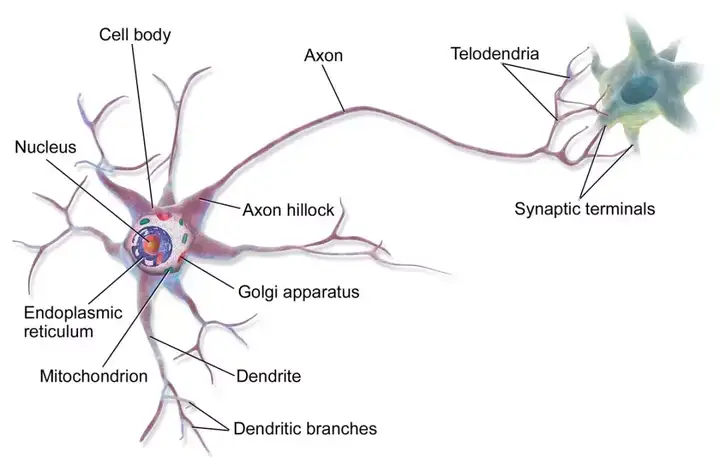
- Dendrites: Rootlike parts of the cell that stretch out from the cell body.
- Dendrites grow to make synaptic connections with other neurons.
- Cell Body: Contains the nucleus and other parts of the cell needed to keep it living (mitochondria, nucleus, Golgi apparatus, ribosomes, etc.).
- Axon': Wire-like structure ending in the terminal buttons that extends from the cell body.
- Myelin Sheath: A fatty covering around the axon of some neuron.
- Terminal Buttons: The branched end of the axon that contains neurotransmitters.
- Neurotransmitters: Chemicals contained in terminal buttons that enable neurons to communicate. Neurotransmitters fit into receptor sites on the dendrites of neurons like a key fits into a lock.
- Nodes of Ranvier: The small gaps between the myelin sheath are the Nodes of Ranvier. These gaps are where neural transmission takes place on myelinated neurons.
- Synapse: This is the gap between the terminal button and the dendrite.
- Synapse.jpg
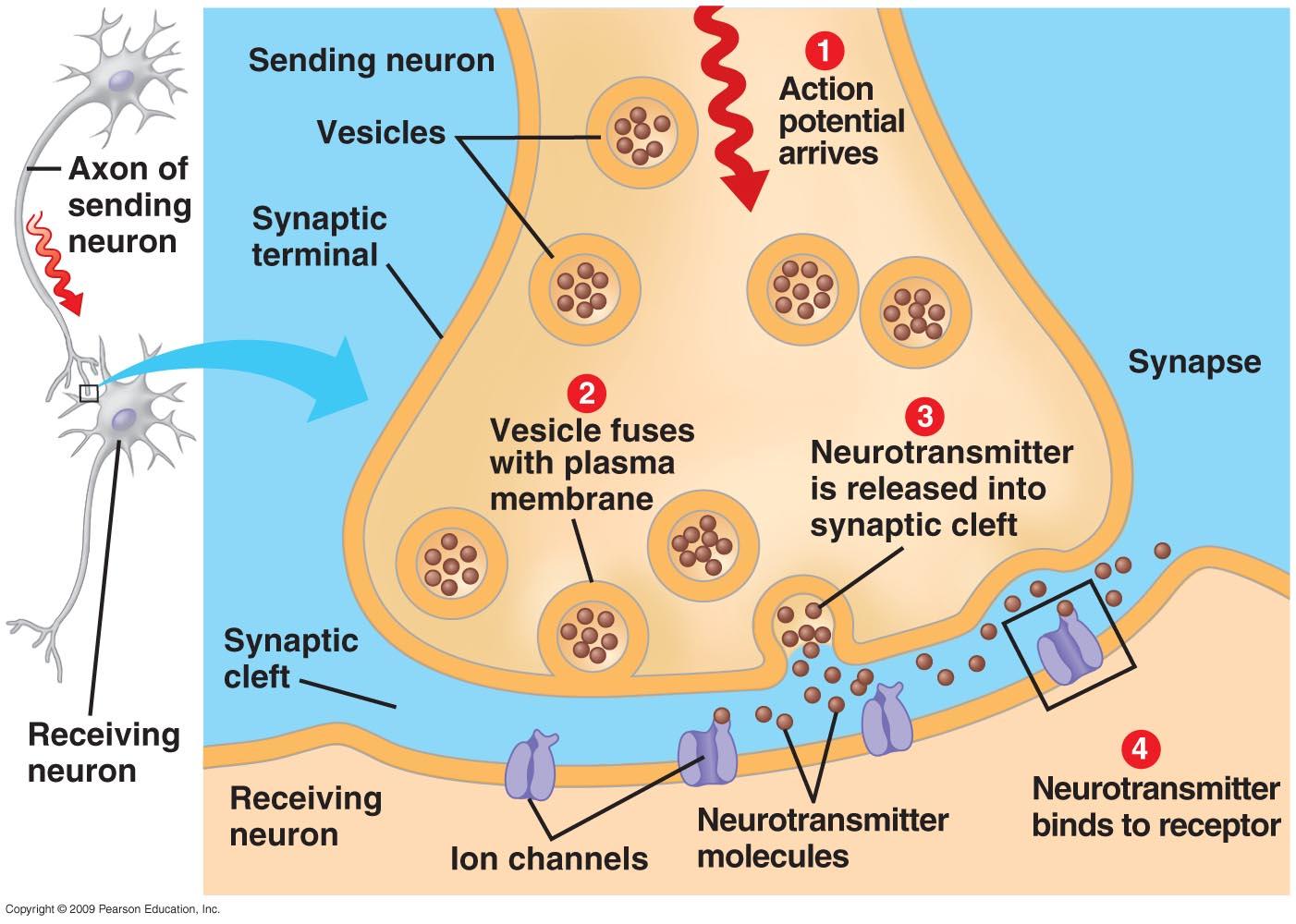
- Neural firing is an electrochemical process. Electricity travels within the cell from the dendrites to the terminal buttons.
- Neurotransmitters travel between cells in the synapses of neurons.
- Electricity does not jump across the synapse; neurotransmitters travel across.
- Neuron has a slightly negative charge (-70mV).
- Neurotransmitters from one neuron land on the dendrites of another neuron.
- The neurotransmitters fit into receptor sites.
- If the threshold is reached, the neuron becomes permeable to positive ions and they rush down the neuron causing it to fire.
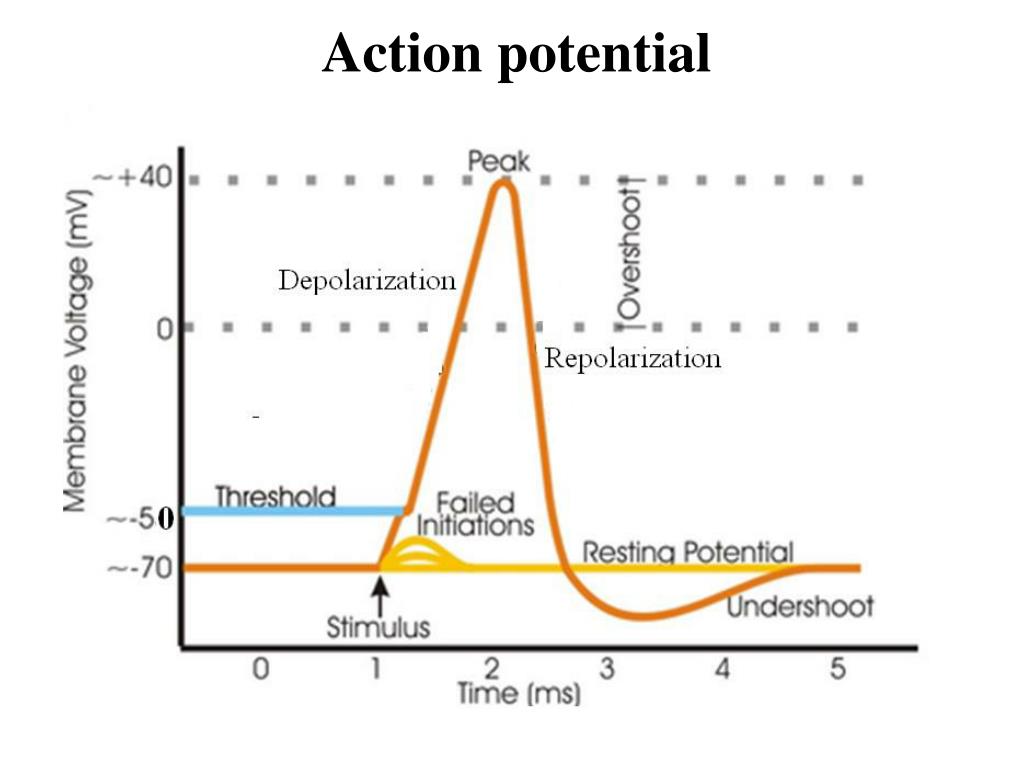
- All-or-nothing Principle: Neurons either fire or don't; this principle is called the all-or-nothing principle.
- A neuron is similar to a gun in that, you cannot shoot the gun just a little.
(Boolean型变量啊嗯)
- Neurotransmitters are chemicals held in the terminal buttons that travel across the synapse to the dendrite of another neuron.
- Some neurons are excitatory, some are inhibitory.
- Excitatory neurotransmitters make the next neuron fire.
- Glutamate is an excitatory neurotransmitter.
- Inhibitory neurotransmitters prevent the next neuron firing.
- GABA(gamma-Aminobutyric acid) is an inhibitory neurotransmitter.
- Acetylcholine is involved in movement, memory function, and muscle contraction (particularly in the heart).
- Dopamine is involved in movement, alertness, attention, reward, and imbalances are associated with Parkinson’s and Alzheimer's disease.
- Endorphins are involved in pain control. They are the body's natural painkillers.
- Serotonin is involved in mood, sleep, pain, sensitivity, and arousal.
- Norepinephrine/Noradrenaline is involved in alertness/arousal.
- Afferent/Sensory Neurons take information from our senses to the spinal cord.
- Interneuron, found in the spinal cord, relays signals between (afferent) sensory neurons, and (efferent) motor neurons; involved in the process of sensory-motor integration.
- Efferent Neurons are conducting cells that carry information from the central nervous system (the brain and spinal cord) to muscles and organs throughout the body.

- A subset of movements are controlled by direct transmission from afferent to efferent cells at the level of the spinal cord.
- Reflexes: Quick and involuntary responses to environmental stimuli.
- Nervous System
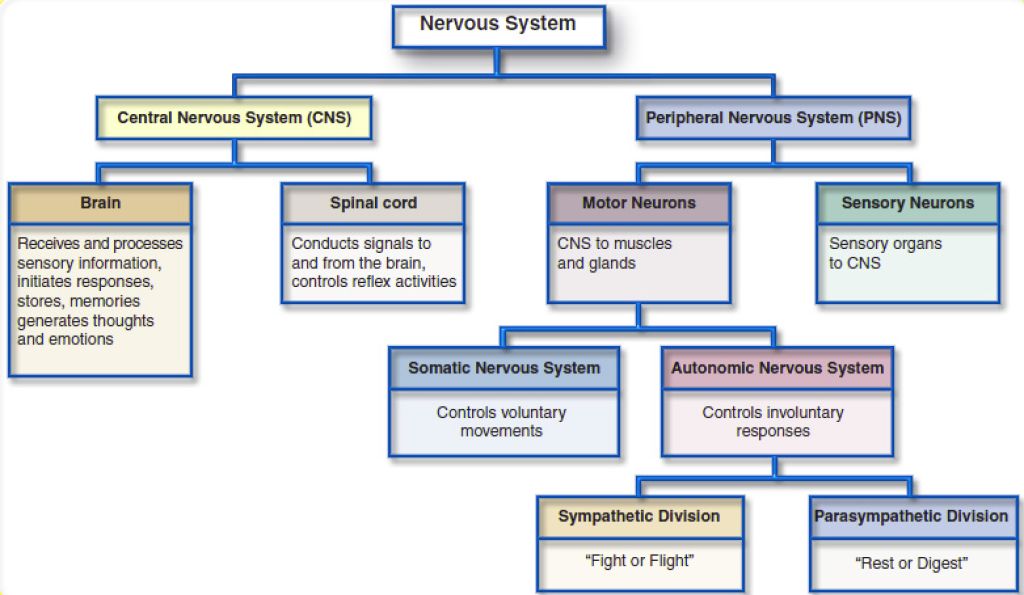
- The CNS (Central Nervous System) is composed of the brain and spinal cord.
- The PNS (Peripheral Nervous System) consists of all the other nerves in your body other than those in the brain and spinal cord.
- ↓The PNS的Motor Neurons is divided into two categories: the somatic and the autonomic. PNS还有Sensory Neurons,效果如其名。
- The somatic nervous system controls our voluntary muscle movements. The motor cortex of the brain sends impulses to the somatic nervous system, which controls the muscles that allow us to move.
- The autonomic nervous system is responsible for control of the bodily functions not consciously directed, such as breathing, the heartbeat, and digestive processes.
- (automatic)The sympathetic nervous system mobilizes our body to respond the stress. It is involuntary.
- This part of our nervous system carries messages to organs, glands, and muscles. The sympathetic nervous system controls heart rate, blood pressures, respiration, and slows non-vital functions such as digestion and reproductive organs.
- Also called the Fight or Flight System.
- The parasympathetic nervous system is responsible for slowing down our body after a stress response.
- The parasympathetic nervous system puts on the brakes to slow down the body’s autonomic nervous system.
- Often referred to as the Rest and Digest System.
- Ways we can study the brain: Accidents, Lesions, Electroencephalogram, Computerized Axial Tomography, Magnetic Resonance Imaging, Positron Emissions Tomography, Functional Magnetic Resonance Imaging.
- Accidents give clues about brain function.
Famous case (1848) of a railroad worker, Phineas Gage who was hit by a piece of rebar in the front of his head. Having sustained damaged to his frontal lobe, and having become highly emotional and impulsive after.- Doctors concluded that the frontal lobe was somehow regulating emotion.
- 扩展文章:真实的不死男:铁棍刺穿头颅却谈笑风生,死后被掘尸研究(文/快哉风)
- Lesion is the removal or destruction of the brain.
- A famous(?) example is doctors who lesioned mentally ill patients who had no other treatment options. Lesions give clues about function.
- Researchers discovered that lesioning a part of the frontal lobe would make the patients calm and relieve some serious mental conditions.
- 扩展文章:“科学”曾这样为恶:游戏《光之镇》的幕后故事(作者:phxfed)
- (本文部分涉前脑叶白质切断术配图可能引起读者不适,请爱眼人士谨慎阅读)
- Electroencephalogram/EEG detects current given off by the electrochemical reactions going on in the brain.
- Neurons use an electrochemical process to send signals.
- Researchers can examine what type of waves the brain produces during different stages of consciousness and use this information to generalize about brain function.
- Widely used in sleep research.
- 脑电图示意图.jpg

- Computerized Axial Tomography/CAT/CT scan is a sophisticated X-ray.
- A CAT scan uses X-ray cameras that rotate around the brain and combine all the pictures into a detailed three-dimensional picture of the brain’s structure.
- The Magnetic Resonance Imaging (MRI) is similar to a CAT scan.
- MRI determines the structure; it gives a more detailed image than CAT.
- An MRI uses magnetic fields to measure the density and location of brain material.
- Does not expose patients to X-rays like a CAT scan.
- 磁共振成像示意图.jpg

- A Positron Emissions Tomography (PET) scan lets researchers see what areas of the brain are most active during certain tasks. It will determine brain function.
- In PET scans of the brain, a radioactive atom is applied to glucose (blood sugar葡 萄 糖).
- If one area of the brain is using more glucose during some activity, (e.g., problem solving, listening, reading, eye movement, etc.), it is a good indication that that area is associated with that mental state or that behavior.
- 正电子成像术示意图.jpg

- Functional Magnetic Resonance Imaging (fMRI) combines elements of MRI and PET scans.
- An fMRI scan can show details of brain structure with information about blood flow to the brain, function.
- Best of both words approach – you can measure structure and function.
- Brain Terminology=
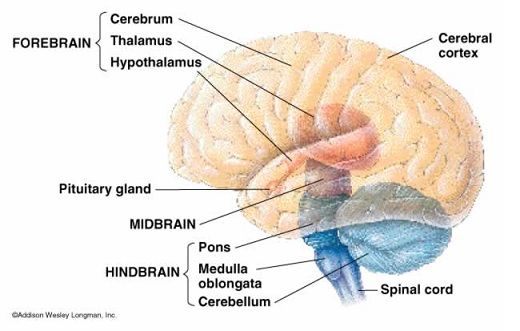
- The hindbrain consists of structures in the top part of the spinal cord.
- The hindbrain controls basic biological functions that keep us alive (respiration, heart rate, blood pressure).
- Important structures within the hindbrain are the Medulla, Pons, and Cerebellum.
- The Medulla, also known as the Medulla Oblongata, located above the spinal cord, is involved in control of blood pressure, heart rate, and breathing.
- Pons, located just above the medulla and toward the front, connects the hindbrain with the midbrain and forebrain. It is also involved in the control of facial expressions.
- The cerebellum (located on the bottom rear) coordinates some habitual muscle movements such as tracking a target with our eyes.
- Cerebellum means little brain, named this probably because it looks like a miniature brain.
- Areas of interest to us in the forebrain that make up the limbic system:
- The thalamus, located on top of the brain stem, is responsible for receiving sensory signals coming from the spinal ford and sending them to the right areas of the forebrain.
- Kind of like an air traffic control person, who directs where the incoming planes should land.
- The hypothalamus, a small structure below the thalamus, controls body temperature, sexual arousal, hunger, thirst, and biological rhythms (wake/sleep patterns).
- The thalamus, located on top of the brain stem, is responsible for receiving sensory signals coming from the spinal ford and sending them to the right areas of the forebrain.

- The hippocampus, looks like two arms surrounding the thalamus, is vital to our memory.
- Memories are processed through the hippocampus and then sent to other locations in the cerebral cortex for permanent storage.
- Research shows that memories or information must pass through this area first in order to be encoded.
- Individuals with brain damage of the hippocampus are unable to retain new information. If the hippocampus is damaged, old information may also be lost.
- The amygdala(挨着海马体的那俩) is very important to certain emotions like fear and aggression.
- The hippocampus, looks like two arms surrounding the thalamus, is vital to our memory.
- The thalamus, hypothalamus, amygdala, and hippocampus (all the brain parts we just covered) are grouped together and are called the limbic system.
- 相关实验:“Mice made to kill”(耶鲁大学)。(scientists-used-light-to-turn-mice-into-stone-cold-killers(washingtonpost))
- Cerebral cortex: Gray, wrinkled stuff that is densely packed with neurons.
- The surface of the cerebral cortex is wrinkled. The big wrinkles are called Fissures.
- Fissures increase the availability of surface area. The more wrinkles, the more surface area contained within the skull.

- The cerebral cortex is divided into two hemispheres: left and right.
- The left hemisphere gets sensory messages and controls the motor function of the right half of the body.
- The right hemisphere gets sensory messages and controls the motor function of the left half of the body.
- This is called contralateral control.
- Hemispheric specialization refers to the different and specific functions performed by the two hemispheres of the brain.
- It is possible that the left hemisphere may be more active during logic and sequential tasks and the right during spatial and creative.
- But this is still under investigation.
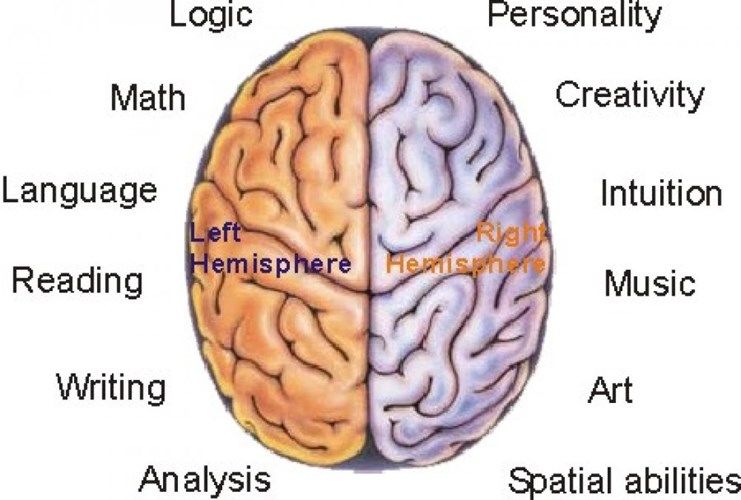
- Split brain patients, patients whose corpus callosum has been cut to treat epilepsy, cannot orally report information only presented to the right hemisphere, since the spoken language centers of the brain are usually located in the left hemisphere.
- Hemisphere

- Corpus Callosum
- Areas of the Cerebral Cortex

- Frontal lobe(蓝), parietal lobe(黄), temporal lobe(绿), occipital lobe(红).
- The frontal lobe is a large area of the cerebral cortex located at the top front part of the brain.
- Within the front lobe, and the very front, is the prefrontal cortex, and is believed to be essential in directing thought processes.
- The prefrontal cortex is said to act as the brain's central executive.
- Researchers believe this part of the brain is responsible for abstract thought and emotional control.
- Broca's area is in the frontal lobe.
- It is responsible for controlling the muscles involved in producing speech.
- Damage to Broca's area might leave one unable to make the muscle movements needed for speech.
- Wernicke's area is located in the temporal lobe.
- Wernicke’s area interprets both written and spoken speech.
- Damage to this area affects our ability to understand language and result in our speech lacking syntax and grammatical structure.
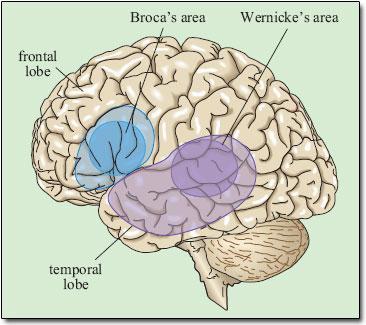
- The parietal lobe is located behind the frontal lobe and at the top of the brain.
- The parietal lobe contains the sensory cortex also known as the somato-sensory cortex.
- The sensory cortex is a thin vertical strip that receives incoming touch sensations from the rest of our body.
- The motor cortex is the region of the cerebral cortex involved in the planning, control, and execution of voluntary movements.
- The sensory cortex, like the motor cortex, is organized top down: The top of the sensory cortex receives sensations from the bottom of the body, progressing down the cortex to the bottom, which processes signals from our face and head.

- The temporal lobe processes sound sensed by our ears.
- Sound waves are processed by the ears, turned into neural impulses, and interpreted in our auditory cortices.
- Our occipital lobe is at the very back of our brain, farthest from our eyes.
- The major function of the occipital lobe is to interpret information from our eyes in our visual cortex.
- Impulses from the retinas in our eyes are sent to the visual cortex to be processed.

- The endocrine system. controlled by the hypothalamus, is a set of glands that secrete hormones that affect many different biological processes in our bodies.
- The hypothalamus produces separate hormones that stimulate or inhibit hormone production in the pituitary gland, known as the master gland.
- The adrenal glands produce adrenaline (epinephrine) which signals the flight or fight response.
- This causes the autonomic nervous system to increase heart rate, breathing, and blood pressure. It prepares our body for action.
- Stressful situations cause the pituitary gland to release adrenocorticotropic hormone, which stimulates the adrenal gland.
- The adrenal medulla secretes epinephrine (adrenaline) and norepinephrine (noradrenaline). These initiate the flight or fight response.
- Women's ovaries and men's testes produce sex hormones. Women produce estrogen in their ovaries, men produce testosterone in their testes.
- The different levels of these hormones explain some differences in behavior like aggression and sexual behavior.
- Many traits, like body shape, introversion, and height result from the combination of nature (genetic code) and nurture (the environment).
- Every human cell contains 46 chromosomes in a 23 pair.
- The genetic material that makes up chromosomes is called deoxyribonucleic acid (DNA).
- Segments of DNA, called genes, control the production of specific proteins that control some human traits.
- A genotype comprises all of the possible combinations of genes; a phenotype is the observable trait.
- Genes can either be dominant or recessive.
- A dominant trait is more likely to be expressed than a recessive trait.
| Expression of Dominant & Recessive Alleles | |
| Alleles Present | Allele Expressed |
| Dominant, Dominant | Dominant |
| Dominant, Recessive | Recessive |
| Recessive, Recessive | Recessive |
- Identical twins or monozygotic twins develop from one fertilized egg called a zygote.
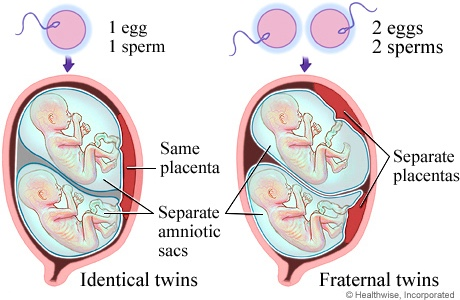
- Research by Thomas Bouchard where he studied monozygotic twins given up at birth showed that IQ does depend slightly on the environment in which you are raised.
- But IQ of twins raised apart are still highly correlated, so genetics still play a large role in how smart you are.
- Furthermore, twins raised in separate families share very similar physical qualities, which may cause others to treat them in similar way, creating the same effective psychological environment for both twins.
- Sometimes chromosomes do not combine normally.
- Turner's syndrome is where the infant has only a single X chromosome.
- Babies and children with Turner;s generally have traits such as shortness, webbed necks, and differences in physical sexual development.
- Klinefelter's syndrome is when males have an extra X, resulting in XXY.
- Sexual development is different and personality like extreme introversion (shyness, lack of social interaction) occurs.
- Down Syndrome: Babies born with down syndrome are born with an extra chromosome on the twenty-first pair.
- Results in rounded face, shorter fingers and toes, slanted eyes set far apart, and intellectual difficulties.